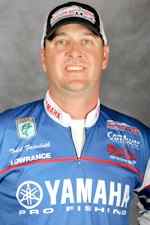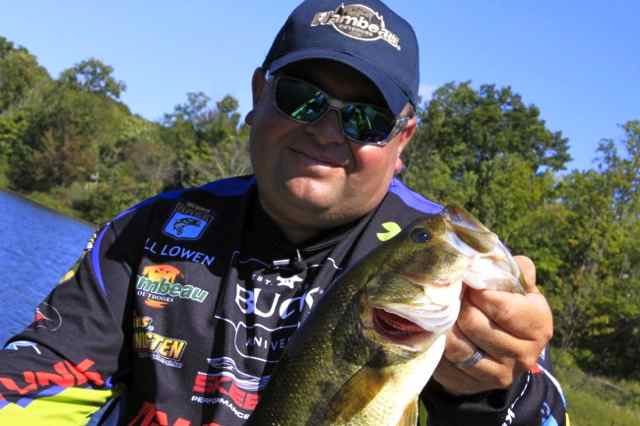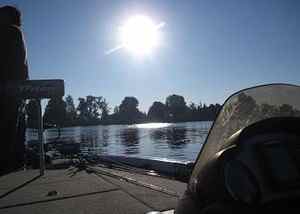Flipping for Fall Bass With Todd Faircloth

by RB Bass
9-12-2013
Website
The Enegizer Bunny and B.A.S.S. Elite Series pro Todd Faircloth share a common trait. While the bunny keeps on ticking, Faircloth keeps on flipping. He never winds down - cast after cast, short, methodical, thorough. Faircloth is like a well-oiled machine as he eases along a grassline. He has full confidence that bass are clustered somewhere in this green cover, and sooner or later he'll find them. When he does, he knows he can "get well" in a hurry. This is a classic warm month pattern, right?
Absolutely, but it's not exclusive to the hot season. Faircloth, of Jasper, Texas, says on many lakes, bass linger in the vegetation into late autumn. "I've caught 'em flipping grasslines in December on Toledo Bend and Sam Rayburn and Lake Amistad," he attests. "Now I may not get as many bites flipping the grass this time of year , but I'll get enough to keep things interesting, and the average size fish I catch will be big - 3 to 4 pounds." This is why other anglers should keep this pattern on the front burner as fall progresses. This time of year most people gravitate to the backs of creeks where shad are working. But Faircloth knows from experience that deep grasslines still hold some good bass this time of year, and he will usually have these fish all to himself. Here is how he racks up some hefty catches when the air is cooling, the leaves are turning and the fish are gorging themselves in anticipation of the cold months ahead.
Location:
"In Texas lakes, I'm usually fishing grasslines in 8 to 20 feet of water, and the water color is clear to slightly stained," Faircloth begins. "The grass usually quits growing at the edge of some sort of dropoff - a creek, ditch, underwater point, etc. The fish travel along these contour breaks, and they use the grass as cover. So anglers should look for contour changes with grass growing on them." More specifically, Faircloth looks both visually and electronically for places where a grassline turns or makes a point. "These bends and points are the most likely places for the bass to concentrate," he notes. "They're natural ambush places where they can hide in the cover and watch for forage fish to swim by." He adds, "Sometimes the grass will be matted up on the surface. Other times it'll be growing to within 2 to 3 feet of the surface, but you can still see it. In both cases, you can find the prime spots just by looking. These are the best conditions for fishing this pattern. "But other times when the grass is a little deeper, you have to depend on your graph to see it and to follow the breaks. Still, the same rules apply. You want to work the edges of the grassbeds and focus mainly on those points and turns in the cover."
Lure Selection:
To do this, Faircloth flips a 1 to 1.5 ounce All-Terrain Tackle Grassmaster jig mated with a Yamamoto Flappin' Hog trailer. His go-to colors are a black/blue jig and a watermelon Hog. He explains, "Bass holding in these deep grasslines in the fall are mainly feeding on bluegill, and this color combination matches this prey species." Faircloth picks his jig size based on water clarity. "The clearer the water, the faster I want my bait to fall, so the heavier the jig I'll use. I'm looking for a reaction bite with this presentation. I don't want the fish to have much time to study the bait. Instead, I want it dropping by them fast so they have to make a split-second decision on whether or not to bite it. I believe this is the best way to trigger strikes in clear water ," Faircloth says.
Presentation:
As he slides along, Faircloth makes a new pitch every 4 to 5 feet, over and over, always just ahead of his boat's bow. When he pitches into the grass, he lets his jig free spool to the bottom. When it hits, he engages his reel, hops it once or twice, then reels it back up quickly and makes the next pitch. He says 90 percent of his bites come on the first drop he makes into a new spot. He calls this technique "speed flipping." He says, "I don't spend a lot of time looking for individual fish. Instead, I'm looking for groups of fish. If I can find a group clustered together in one small area, I can load up in a hurry." Faircloth adds, "It's amazing how much water you can cover fishing like this, and this is what you have to do. You just keep working those grass edges and searching until you hit a place where some bass are holding. You might go a long way without a bite, then you'll hit an area the size of a pickup truck where the bass will be gathered up. This is what you're looking for. This is where you can put together a good limit in just a few minutes." Faircloth continues, "When you hook a fish, you need to land it and get your bait back in the same spot as fast as you can. When you catch one, it's important to keep the bite going. If you're fishing with a partner, he needs to get his bait in there quickly. It's commonplace to get a double in this situation."
Absolutely, but it's not exclusive to the hot season. Faircloth, of Jasper, Texas, says on many lakes, bass linger in the vegetation into late autumn. "I've caught 'em flipping grasslines in December on Toledo Bend and Sam Rayburn and Lake Amistad," he attests. "Now I may not get as many bites flipping the grass this time of year , but I'll get enough to keep things interesting, and the average size fish I catch will be big - 3 to 4 pounds." This is why other anglers should keep this pattern on the front burner as fall progresses. This time of year most people gravitate to the backs of creeks where shad are working. But Faircloth knows from experience that deep grasslines still hold some good bass this time of year, and he will usually have these fish all to himself. Here is how he racks up some hefty catches when the air is cooling, the leaves are turning and the fish are gorging themselves in anticipation of the cold months ahead.
Location:
"In Texas lakes, I'm usually fishing grasslines in 8 to 20 feet of water, and the water color is clear to slightly stained," Faircloth begins. "The grass usually quits growing at the edge of some sort of dropoff - a creek, ditch, underwater point, etc. The fish travel along these contour breaks, and they use the grass as cover. So anglers should look for contour changes with grass growing on them." More specifically, Faircloth looks both visually and electronically for places where a grassline turns or makes a point. "These bends and points are the most likely places for the bass to concentrate," he notes. "They're natural ambush places where they can hide in the cover and watch for forage fish to swim by." He adds, "Sometimes the grass will be matted up on the surface. Other times it'll be growing to within 2 to 3 feet of the surface, but you can still see it. In both cases, you can find the prime spots just by looking. These are the best conditions for fishing this pattern. "But other times when the grass is a little deeper, you have to depend on your graph to see it and to follow the breaks. Still, the same rules apply. You want to work the edges of the grassbeds and focus mainly on those points and turns in the cover."
Lure Selection:
To do this, Faircloth flips a 1 to 1.5 ounce All-Terrain Tackle Grassmaster jig mated with a Yamamoto Flappin' Hog trailer. His go-to colors are a black/blue jig and a watermelon Hog. He explains, "Bass holding in these deep grasslines in the fall are mainly feeding on bluegill, and this color combination matches this prey species." Faircloth picks his jig size based on water clarity. "The clearer the water, the faster I want my bait to fall, so the heavier the jig I'll use. I'm looking for a reaction bite with this presentation. I don't want the fish to have much time to study the bait. Instead, I want it dropping by them fast so they have to make a split-second decision on whether or not to bite it. I believe this is the best way to trigger strikes in clear water ," Faircloth says.
Presentation:
As he slides along, Faircloth makes a new pitch every 4 to 5 feet, over and over, always just ahead of his boat's bow. When he pitches into the grass, he lets his jig free spool to the bottom. When it hits, he engages his reel, hops it once or twice, then reels it back up quickly and makes the next pitch. He says 90 percent of his bites come on the first drop he makes into a new spot. He calls this technique "speed flipping." He says, "I don't spend a lot of time looking for individual fish. Instead, I'm looking for groups of fish. If I can find a group clustered together in one small area, I can load up in a hurry." Faircloth adds, "It's amazing how much water you can cover fishing like this, and this is what you have to do. You just keep working those grass edges and searching until you hit a place where some bass are holding. You might go a long way without a bite, then you'll hit an area the size of a pickup truck where the bass will be gathered up. This is what you're looking for. This is where you can put together a good limit in just a few minutes." Faircloth continues, "When you hook a fish, you need to land it and get your bait back in the same spot as fast as you can. When you catch one, it's important to keep the bite going. If you're fishing with a partner, he needs to get his bait in there quickly. It's commonplace to get a double in this situation."
< Previous Report Next Report >
< Previous Report
Next Report >

: Tournament Bass Tips to Improve your success
: Bill Lowen’s Fall Bass Lure Selection

California Delta: Delta Fishing Report, August 26, 2013
California Delta: Bass Fest draws over 180 Boats! See the results!
More Reports
RB Bass Reports
for Thursday, September 12th, 2013
: Tournament Bass Tips to Improve your success
: Bill Lowen’s Fall Bass Lure Selection
RB Bass Reports
for Tuesday, August 27th, 2013
California Delta: Delta Fishing Report, August 26, 2013
California Delta: Bass Fest draws over 180 Boats! See the results!
000


